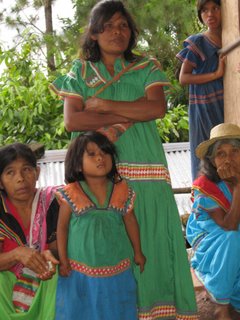A lot has happened since my last post. I finished with training at the end of October and moved into my site permanently after a weekend of fun on the beach for Halloween. So far things have gone well and I´m enjoying the "real Peace Corps experience" a lot more than training. There are certainly good days and bad days but overall I really love it.

Celebrating the end of Santa Clara.
I´ve spent most of my time so far shadowing my host family around and getting to know the community (about 7 homes, maybe 100 people). I spend about two out of every three days working in the fields with my host dad. We have finished harvesting the season´s rice and have cleaned the fields for the next crop: beans. We´ve also been harvesting some coffee and yucca. Sorry, I´m not a coffee drinker, so I really don´t know if it´s good or not. However, they give me tea made from lemon grass and hot chocolate made from fresh cacao two to three times a day and both are amazing!
As for meals, all we really eat is rice. I get a bowl for breakfast, lunch, and dinner. Occasionally there will be a piece of yucca or some other vegetable, but mainly rice. There was one dinner where I got half a pumpkin, which was pretty good (certainly the change was welcome). We killed an armadillo in the fields a few weeks back, which I was interested in trying, but another family got the meat...I´ll get my chance. Talking to friends at Thanksgiving, I´m pretty lucky to be getting rice. Most of them are eating boiled green bananas three times a day! Once I get my own house built I´ll be cooking for myself and able to carry in food from outside, so I should be eating a wider variety then.
 New environmental health volunteers at swear in.
New environmental health volunteers at swear in. I did try buying 10 pounds of beans and giving them to my family to cook with the rice. They loved the gift, but instead of eating them we immediately went out to the fields to plant them. Hopefully in about three months those 10 pounds will be 30 pounds of beans. However, I imagine they will turn around and plant them again anyway!
 Do you think she knows she´s chewing on the Panamanian flag?
Do you think she knows she´s chewing on the Panamanian flag? In terms of projects, not a lot happens the first six months of the volunteer's time in site as they become acclimated to the new culture. However, January to March is the dry season and the best time to put holes in the ground for latrines. That said, I´m planning to put 10 to 30 latrines in this dry season so they don´t have to wait another year to see some progress there. Also, I´ll be measuring the water´flow and monitoring 3 to 4 aqueduct systems in both my community and surrounding areas to design for improvements and additions over the coming two years. Currently drinking water is not a problem in Laguna, but there are several small communities scattered nearby that want their own systems set up.





























